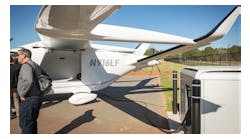Back in 2012 when Congress ordered the FAA to integrate Unmanned Aerial Systems into U.S. airspace, it happened to be the 50th anniversary year of another ambitious directive: President John F. Kennedy’s 1962 moonshot declaration. “We choose to go to the moon in this decade and do the other things, not because they are easy,” Kennedy had famously said, “but because they are hard.”
Integrating UAS into our national airspace may not rank next to the moonshot in the annals of human achievement. However, it is similar in at least one respect: It will most certainly be hard.
The extent of the challenge comes into sharp focus in a new report by Altiscope, the unmanned traffic management group of Airbus’ Silicon Valley innovation outpost A³ by Airbus. Titled Blueprint for the Sky: The Roadmap for the Safe Integration of Autonomous Aircraft, the 26-page analysis includes detailed explorations of a raft of challenges and opportunities. (In my capacity as an aviation attorney, I was among the report’s reviewers, particularly in the area of risk-management.)
As the report notes, our skies are about to get much busier. By some estimates, commercial air traffic will double within 15 years even as the UAS world continues to grow. The FAA has already registered at least a million drones, note the report’s authors, and last year alone about three million UAS were shipped worldwide. Meanwhile, entrepreneurs based everywhere from Silicon Valley to the United Arab Emirates are hard at work on larger-scale UAS that could one day be used as fully autonomous sky taxis, cargo delivery vehicles or airborne ambulances.
As a major manufacturer focused on next-generation aviation, Airbus is acutely aware of the need for an air-traffic management system that can handle these new demands without compromising the extraordinary safety and efficiency we enjoy today. In this, Airbus joins NASA and the FAA, both of which are actively studying such questions.
The latter agency, in particular, has taken some “baby steps” of late that are worth noting. This past August, participants in the FAA’s UAS Integration Pilot Program successfully completed several trials focused on helping the agency better understand UAS capabilities and potential regulatory issues related to airspace integration. The trials in Oklahoma, Virginia, North Carolina and Kansas included using a drone to deliver medical supplies to a rural area; testing drones beyond the line of sight; and even using a drone to deliver an ice cream cone to a child.
Since issuing its Part 107 UAS rules in June 2016, the FAA has gradually ramped up its focus on integrating drones into the national airspace. To date, it is has issued at least 2,000 waivers enabling pilots to operate UAS in ways not specifically authorized by Part 107. The agency has also issued at least 100,000 pilot certificates for commercial UAS operation.
Libertarian-leaning go-getters in Silicon Valley tend to see this as plodding progress. However, it is important to remember that the FAA’s overriding mantra is to never derogate the safety of U.S. airspace. Naturally, regulators are cautious about allowing operators to fly UAS in ways that could carry risks, such as piloting drones beyond the line of sight. Nonetheless, FAA recognizes that the drone industry will not be able to move forward without expanding or eliminating many of today’s boundaries. These early tests are about moving the regulatory framework in that direction.
For its part, the Blueprint offers an integration action plan in broad outline. The report’s authors describe the limits of the current human-centric approach to air traffic management and make the case for an integrated, digital system capable of handling manned and unmanned flights equally well. They sketch out how such a system could work and provide an overview of related research efforts in the United States, Japan, China and Europe. The report also includes suggested operating principles that, in the authors’ view, will be needed for UAS-integrated airspace to thrive: They contend that airspace must be shared, harmonized worldwide, accessible and capable of accommodating future demand; note that safety and security must be paramount; and assert that drones must be allowed to self-pilot and fleets to self-manage. Adaptable models in four areas—airspace, systems, regulations and stakeholders—offer guidance on future roles, rules, configurations and management challenges.
Taken together, the efforts of Airbus, the FAA, NASA and various European and Asian agencies amount to early—but significant—milestones on the path to UAS integration. Bringing a new traffic-management system into reality will require deep involvement on the part of nearly all parties involved in the aviation business today, including airport operators. “The blueprint for a safe, efficient, and fair sky,” the authors write in the conclusion to the Blueprint, “must be developed together.” I wholeheartedly agree and encourage aviation stakeholders to join in this important dialog.
Those interested in learning more can download the Blueprint at no cost by visiting UTMBlueprint.com.
Veteran aviation attorney Mark A. Dombroff is an Alexandria, Va.-based shareholder in LeClairRyan and co-leader of the national law firm’s aviation industry practice; [email protected].



